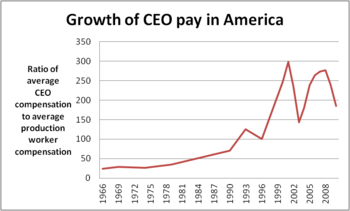
In economics, the wage ratio refers to the ratio of the top salaries in a group (company, city, country, etc.) to the bottom salaries. It is a measure of wage dispersion.
There has been a resurgence in the importance of the wage ratio. The amount of money paid out to executives has steadily been on the rise. In the US "an April 2013 study by Bloomberg finds that large public company CEOs were paid an average of 204 times the compensation of rank-and-file workers in their industries. By comparison, it is estimated that the average CEO was paid about 20 times the typical worker’s pay in the 1950s, with that multiple rising to 42-to-1 in 1980, and to 120-to-1 in 2000".[3] While not as extreme, similar trends have been observed around the world.
Research suggests that consumers believe CEO pays ratios are far lower than they actually are; in fact, consumers’ ideal ratio of CEO pay to average unskilled worker is 4.6 to 1, while their estimated actual ratio of CEO pay to average unskilled worker pay is 10 to 1.[4]
- ^ "Methodology for measuring CEO compensation and the ratio of CEO-to-worker compensation". Economic Policy Institute. May 2, 2012.
- ^ "More compensation heading to the very top". stateofworkingamerica.org. February 15, 2011. Archived from the original on November 24, 2011.
- ^ Aguilar, Louis A. "SEC Open Meeting". Sec.gov. Retrieved 6 December 2013.
- ^ Mohan, Bhavya; Norton, Michael I.; Deshpande, Rohit (2015). "Paying Up for Fair Pay: Consumers Prefer Firms with Lower CEO-to-Worker Pay Ratios" (PDF). SSRN Electronic Journal. Elsevier BV. doi:10.2139/ssrn.2611289. ISSN 1556-5068. S2CID 167620304.